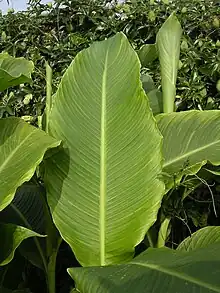Canna tuerckheimii
Canna tuerckheimii is a species of the Canna genus, belonging to the family Cannaceae. Its specific epithet tuerckheimii commemorates Hans von Türckheim, a 19th-century German plant collector.[1]
| Canna tuerckheimii | |
|---|---|
 | |
| Leaf form | |
| Scientific classification | |
| Kingdom: | Plantae |
| Clade: | Tracheophytes |
| Clade: | Angiosperms |
| Clade: | Monocots |
| Clade: | Commelinids |
| Order: | Zingiberales |
| Family: | Cannaceae |
| Genus: | Canna |
| Species: | C. tuerckheimii |
| Binomial name | |
| Canna tuerckheimii | |
| Synonyms | |
| |

Description
Herb up to 5 m tall.[2] Canna tuerckheimii is a relatively large species with vast stems carrying large green leaves and high carried orange-red flowers. Stems of up to 3 — 3.5m (11½ft) in height. Green leaves, relatively large - 30–100 cm x 15–40 cm (12—36in x 6—16in), lower side and sheaths lanuginose. Flowers are erect orange-red, 5.5 –9 cm (2¼—3½in) long; floral tube not curved, composed of 9 coloured parts; petals not reflexed; with 4 staminodes.[3]
Distribution
Canna tuerckheimii is native to Belize, Costa Rica, Guatemala, Honduras, Mexico, Nicaragua, Panama, Colombia and Ecuador at 500–2,000 m (1,600–6,600 ft) of elevation.[4]
Taxonomy
Paulus Johannes Maria Maas and Nobuyuki Tanaka, both experts on the genus Canna, disagree on the correct taxonomic placement of this species, with Tanaka considering the correct placement for the species to be C. latifolia.[3]
Cultivation
It is hardy to zone 10 and is frost tender. In the north latitudes, it is in flower from August to October, and the early seeds ripen in October.[2]
References
- Quattrocchi, Umberto (2016). World Dictionary of Medicinal and Poisonous Plants. CRC Press. p. 779. ISBN 978-1-4822-5064-0.
- Cooke, Ian, 2001. The Gardener's Guide to Growing cannas, Timber Press. ISBN 0-88192-513-6
- Tanaka, N. 2001. Taxonomic revision of the family Cannaceae in the New World and Asia . Makinoa ser. 2, 1:34–43.
- Kew Gardens, Checklist of plant families
External links
 Media related to Canna tuerckheimii at Wikimedia Commons
Media related to Canna tuerckheimii at Wikimedia Commons Data related to Canna tuerckheimii at Wikispecies
Data related to Canna tuerckheimii at Wikispecies- Proposal to conserve the name Canna tuerckheimii